Maggie Callahan, Sr. Director of Revenue Enablement at Convercent, gave this talk at the Sales Enablement Festival in October 2020.
As a Sales Leader, have you ever color-coded your calendar to keep track of all your weekly meetings? Sat in a recurring meeting and wondered why you’re rehashing the same conversation? Struggled to figure out how to optimize your time and become the best sales coach you can be?
Same. That’s why I’m maniacal about the operating cadence, and in this article, I’ll cover how to define it, how to prioritize it and set the proper intentions, and discuss sales coaching and how we can bake this into how we optimize our sales coaching time.
My name is Maggie Callahan, I am the Senior Director of Revenue Enablement at Convercent. We are an ethics and compliance software company.
I am a maniacal freak about operating cadences.
Because you're reading my article on conquering your operating cadence, I'd imagine that your life looks a little something like this.
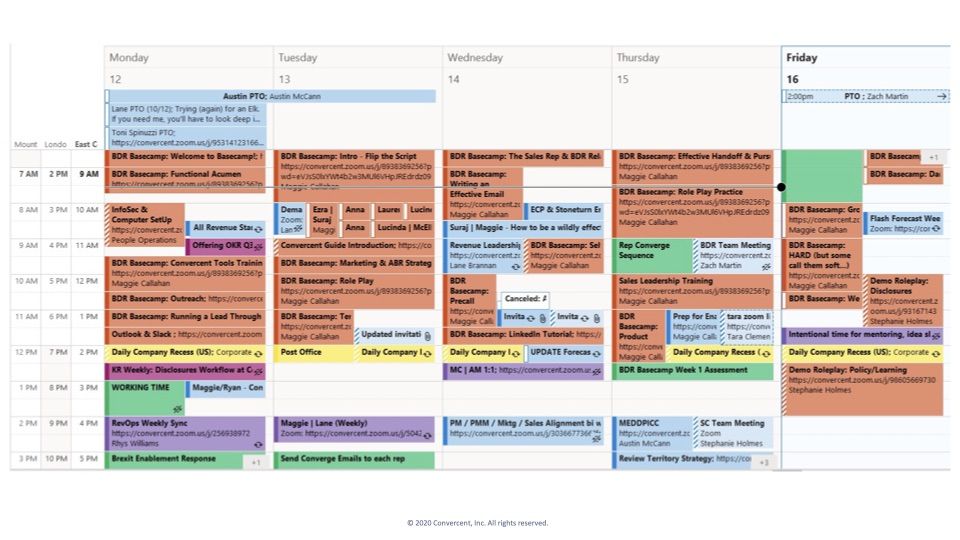
I know, it gives me agita, just looking at it. What I'd imagine you're probably thinking is, "I need to figure out first and foremost, how to make sure I'm optimizing the meetings that I'm in because I don't have that much extra time".
Or the second is, "I tend to sit in meetings all week, and nothing happens. How can I make sure I am effectively coaching as a sales leader, and ensuring something is actually coming out of the meetings I'm having?"
It's one of the most frustrating things for any of us sales leaders in the trade.
The agenda
I'm going to talk first about how we actually define an operating cadence. What does it mean to each of us? And, how do we think about it today? Versus how might you think about it when you've finished reading this article.
The second piece I'm going to talk through is what are the common meetings that really should be existed in your operating cadence in order to ensure your entire team and you as a leader are reaching the goals and managing to the success you want to manage?
The third piece I'll talk about is how do you prioritize your operating cadence and set the proper intentions not only for yourself, and your fellow leaders, but also for your individual contributors, for your team members? Making sure there is buy-in and they are a part of the creation of the operating cadence process.
Finally, sales coaching, how do we bake this into how we can optimize our sales coaching time? If you are a small organization, or a leader in a small organization reading this, you may be thinking to yourself, "My operating cadence consists basically of having to micromanage opportunities or sell on my own because my team is small, and I don't have the opportunity to actually coach my people". That's really common.
I'm going to talk about some open-ended questions that you can leverage to optimize the time you have with your team and make it feel like you actually can coach again.
If you’re a sales leader for a large organization, and you have the time to coach your team, one of the things that tend to happen is we consolidate all of our operating cadence meetings so that our forecast meeting sometimes turns into a pipeline meeting or turns into a territory meeting. I'm going to talk about how you can stay on track with the sessions you have allotted for your team members.
Of course, I have to close it out with how in the world can you learn more? If you like what you read and want to learn more about how you can optimize your operating cadence.
The role of sales leaders
First and foremost, I like to start every single one of my sessions with sales leaders with a quote by John Buchan. John Buchan was a historian and politician in Canada, a Scottish politician in Canada, in 1935.
He said this, "The task of leadership is not to put greatness into people, but to elicit it for greatness is there already".
I start every leadership coaching session with this quote, and actually get printouts of it, and put them in frames for all of the sales leaders at Convercent. Because it is so easy to think that as sales leaders, it is our responsibility to inflict our greatness, our successes into our people.
Individual success doesn’t equal coaching prowess
We can sometimes go off the deep end thinking if I've been successful with sales or with a specific aspect of my career, then I'm going to be fantastic at coaching it. I'm here to ruin your dream of that, unfortunately.
Just because we are fantastic individual contributors doesn't necessarily mean we have everything down to coach our teams effectively.
Lack of performance doesn’t equal lack of greatness
The second piece is, just because one of your reps may not be performing to the degree you are expecting them to perform, it doesn't mean they're not necessarily great, it might mean we're pushing them in a way that is not meant for them.
Their greatness is there somewhere and your responsibility as a coach, and as a leader is to help them find it and help them completely soar to whatever level of success they want to accomplish and achieve.
As I go through this article, and as you proceed after this article into your day to day operations, I want you to take away if anything, that everybody has some greatness in them, it's not our responsibility to put it into them, it's our responsibility to elicit it from them.
The operating cadence
Let's talk about what an operating cadence actually is.
Defining operating cadence
When looking this up, because I always tried to define what I'm talking about beforehand, I found what I feel is a pretty solid definition from Dave Williams of the Chameleon Collective.
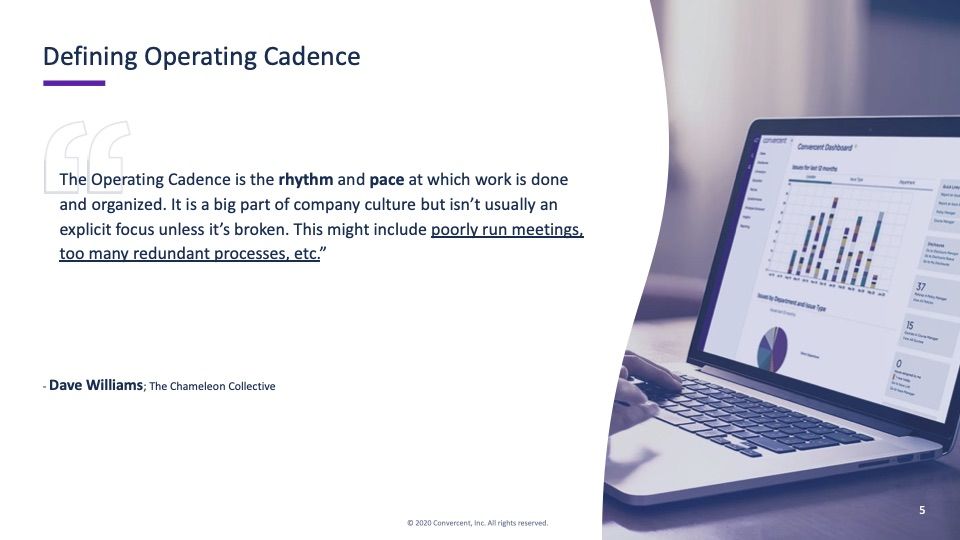
He says the operating cadence is first and foremost, the rhythm and the pace at which work is done and organized usually on your teams. It's a big part of company culture and can either exude your company culture, so express your company culture or become a detriment to your company culture.
But it isn't usually an explicit focus unless it is broken. What he's saying there is people don't necessarily talk about the operating cadence until they realize the operating cadence is not being done well.
We tend to not be proactive about what we need from the sessions that we run on a weekly basis, usually, depending on if that's our rhythm until we recognize those sessions are not really having the outcome we want them to have.
Those might include poorly run meetings, too many redundant processes, frustrations, time management, etc. When we define our operating cadence, we want to be hyper-focused on first and foremost:
- How often are we meeting?
- What's the rhythm? And
- Are we at the right pace?
- Is this how frequently we should be meeting? Or
- Does this topic of conversation require more frequent sessions? Less frequent sessions?
- Are we defining what the purpose and intention are?
Common sales cadence
If you are a leader of a sales team today, you are probably thinking to yourself, "Alright, I have a pretty good operating cadence", you probably include one of these five sessions within your operating cadence.
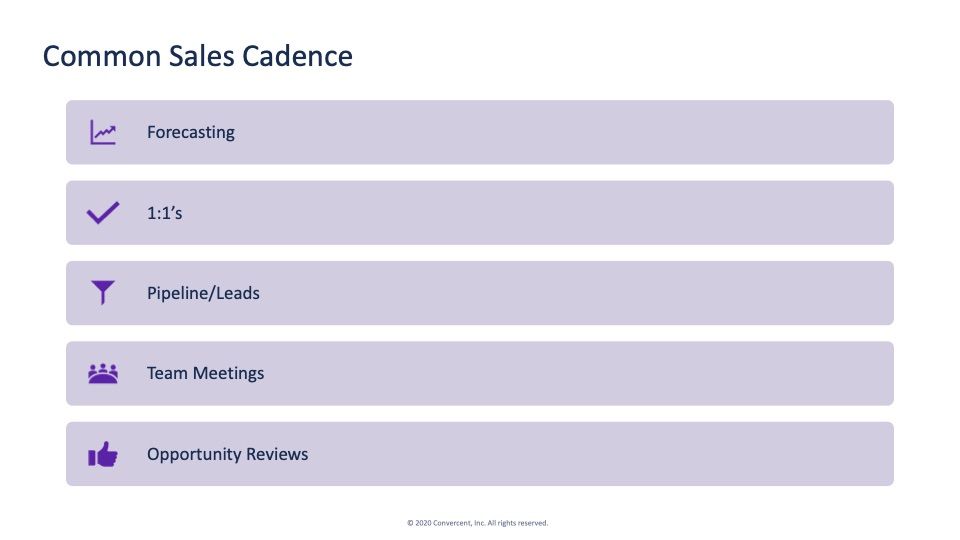
Forecasting
We have forecast meetings:
- What's coming in?
- What's not coming in?
- What's committed?
- What's best case?
- What's pipeline?
1:1’s
We have our one on one sessions, one on one time so we can work through professional development with our individual contributors.
Pipeline/Leads
We may have pipeline or lead meetings:
- What's in our pipeline?
- How are we managing our pipeline?
- How are we nurturing our pipeline?
- Where's our pipeline coming from?
Team meetings
We have our team meetings, our larger group rather than just the one-on-one to share information, bring in people from other areas of the company.
Opportunity reviews
Then we, of course, have our opportunity reviews - specific deals, deal strategy, maybe you follow BANT, maybe you follow MEDDPICC, and how are those opportunities being executed upon by your team members?
You may be looking at this list of five and thinking to yourself, "Yeah, we have all five of those". That's great.
Are they going well? I want you to ask yourself that question first.
- Do you feel like in all five of your sessions you get out exactly what you want to get done? And
- Your conversion percentages, your pipeline maintenance, your average sales price, your close rates, are continuously increasing or decreasing depending on what's positive?
That would be the first question I ask. The second piece is, some of you might be looking at this list of five and saying "How in the world are any of those different from one another outside of maybe team meetings and one on ones? I do all of my forecasting, pipeline, leads, and opportunity reviews in my one on one". That's really common and I'm here to talk to you about why it is so important to separate these out.
Not so you can add more operating cadence meetings to your calendar every week but so you can accomplish whatever the largest priorities are for your sales organization right now.

The four keys to effective operating/leadership cadence
Usually, when I talk about this, first I talk about making sure you're conscious of the four key areas that will make the largest difference for your sales coaching. These four key areas to effective leadership cadences are as follows.
Opportunities
How many opportunities do you have?
This is the lifeblood of your sales organization. We all know this, I don't have to tell any of you this. The more opportunities you have, the more you have in the pipeline, the more opportunities you have to close. So:
- What is the composition of your opportunities?
- Are they high ARR, are they low ARR, and why might that be happening?
- How are you continuing to hit your pipeline targets?
- What pipeline target do you even have to hit based on your closed percentage? If you're closing only 25% of opportunities in your pipeline, you're going to need 4X pipeline.
- How are you thinking about the opportunities that are existent in your pipe?
Pace
- How are your opportunities moving through every single stage of your stage advancement criteria?
- How are your reps and your leaders spending their extra time during the week?
- What are you doing to ensure that the opportunities that are in pipeline are getting the attention they need?
- And that they are forecasted accurately?
- Are they in best case? Are they in pipeline? Are they in commit? Or whatever it is you put as your nomenclature vernacular on your stage advancement.
Deal strategy
- Are you currently leveraging a specific sales methodology? And
- Are all of your people, your individual contributors following that?
- If so, can they play back a deal strategy to you in relation to MEDDPICC, in relation to BANT, in relation to the challenger sale, in relation to SPIN Selling, in relation to value-based selling?
- Based on that, do they have multi-threaded opportunities?
- Are they speaking to enough people?
- Have they mapped out their buyer landscape, potentially?
- Have they identified effective next steps not only on their side of the house but on the customer side of the house? Is it mutual?
- Have they agreed upon paperwork?
Those aspects of your deal strategy are going to be really tangible in relation to whatever sales methodology your organization follows?
At scale
- Can they optimize all the opportunities they have and run similar plays or the plays they know they need to run at the right time, in the right opportunities, and ask for help in the right ways?
- Are they sharing with their team members best practices?
- Are there great stories of successes and failures so the larger organization gets to learn from one another?
Now, you may be looking at this list of four key effective operating or leadership cadences and thinking to yourself, "Well, where do I even start? Because I recognize I need to include all four of these aspects into my operating cadence. But I am having issues with everything from pipeline maintenance to negotiation tactics way later in an opportunity".
Where to start
Where in the funnel, do you start with your coaching? Here's my suggestion, my piece of advice from enablement to all of you, as sales leaders. Always look towards the areas that are going to have the most effect or if you pull that lever, everything else can begin to waterfall.
For Convercent, initially, that was really:
- How do we manage our pipeline?
- How do we see what pipeline is coming in from our business development team?
- Are our sales reps prospecting on their own?
- Do we have 4x, 3x, 2x coverage?
- Are we handling our pipeline nurture?
- Do we have a pipeline nurture strategy?
From there, when we understand that we will have a better insight into what then gets moved or converted into our stage one opportunities, which we can then track conversion percentages, should our conversion percentages have been low.
We can track how many buyers our reps have in an opportunity. We could really pull that lever of pipeline maintenance and pipeline strategy and that would help us to then waterfall all of the rest of the aspects of our operating cadence in conjunction with that first lever we've pulled.
How might this look for you?
When we think about our operating cadence we want to think about it in two ways. We first want to think, what do we need to do independently, one on one with our team members?
But then also, what do we want to do as a team? What do we want to do with more than just a one on one session, in team meetings?
Operating cadence 101
If we start to, again, waterfall, our opportunities, pace, deal strategy, and at scale into specific meetings, we start to actually cut it up and it starts to become bite-size.
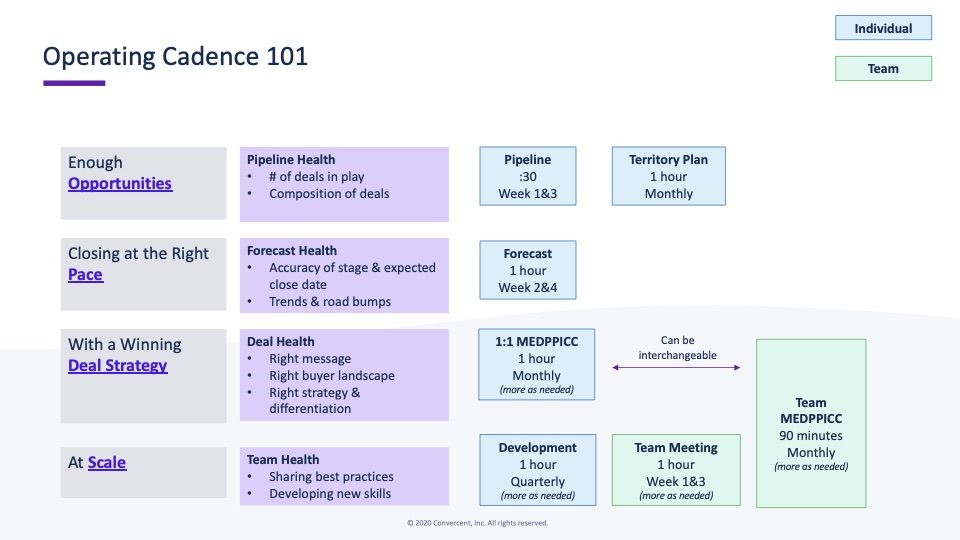
Opportunities
Do we have enough opportunities?
Pipeline health
Where this tends to play the largest role, as I just mentioned, is in our pipeline health. When we define pipeline health, that usually is composed of two areas.
# of deals in play
First and foremost, do we have enough deals in play period?
- Are we getting enough at-bats from our business development team?
- Are they quality?
- Are they only quantity?
- How are we qualifying them once we are in pipeline? And,
- How are we moving them through?
Composition of deals
The second is what is the composition of these deals? I heard an amazing analogy that I love to use now around the composition of deals called whale, tuna, and guppy.
- Are you a rep that has a majority of guppies in your pipeline?
- Those deals that depending on your RR are less than $5,000?
- Do you have more of the tunas that are in between, say the $10-25,000 range?
- Or do you have the whales that are over 100 grand?
- If you hit one of them, you could potentially hit your quota for the quarter? And
- Where are you spending your time based on the composition of those opportunities?
This then waterfalls into the rest of the four key areas of our operating cadence strategy.
Pace
Forecast health
The second being pace, what's our forecast accuracy?
- Do we have good forecast health?
- Are we moving opportunities through their stage advancement criteria in the expected dates that we expect of our team just based on our general average sale cycle?
- And what are the trends we're seeing with forecast accuracy? Based on our commitments and best cases for our team.
- Do we have people that are sandbagging?
- Do we have people that are committing more than they know that they can get in because they're just trying to commit their number? That's really common as well.
Deal strategy
Deal health
With a deal strategy, we want to, of course, ensure that we have some type of one on one session with our team members to give them true independent coaching. But then also, if you don't have the time to do that, incorporate this into a team meeting.
- How can your team members build off of one another and build strategies together based on all of their experiences?
- Are we sending the right message to our prospects?
- Are we identifying the right buyers as we're trying to multithread?
- Do we have the right differentiation for the competition that's involved in this opportunity?
- Are we identifying the decision criteria and decision process early on?
- Or are we forgetting?
- How are we pricing this deal strategy?
Scale
Team health
Then we go into team health which really helps us to identify not only best practices, but it offers a great opportunity to develop new skills around all of the other areas of the operating cadence.
When I bake this out, I bake it out in separate sessions that either occur once every other week or monthly. This will really help you to first of all cut back on unnecessary meetings you may be currently having weekly.
Secondarily, it helps you to really understand what you're going into your leadership forecast meetings or your leadership pipeline meetings with because they are happening frequently enough.
Frequency
You can see in the image above (Operating Cadence 101) suggestions for how often you should be having pipeline meetings and how often should these be solely pipeline meetings. Not pipeline and territory meetings, not pipeline and forecast meetings, not pipeline and deal strategy meetings, but true pipeline meetings, as opposed to forecast meetings.
Again, not forecast and pipeline meetings, not forecast and territory meetings, not forecast and MEDDPICC meetings or deal strategy meetings - true sole forecast meetings.
Learning by osmosis
If you don't have the time because you’re strapped and you’re a small team, and you don't really have the access to coaching all the time for your team members, use your team members as assistants to help you coach.
Get learning by osmosis, do team forecast, team pipeline sharing so you can continuously share best practices.

Coaching vs. not coaching
I mentioned we at Convercent started this all off with our pipeline health. We wanted to figure out how in the world we were going to ensure we had the right pipeline, and we were managing our pipeline effectively. We had to start all of that by helping our leaders understand what coaching looked like, and what it didn't look like.
I'm going to highlight this quickly and bring us back around to our quote by John Buchan that we can't force greatness into anybody, but we can elicit greatness for it's already there.
Observing your seller in action vs. taking over the sale
As we go into how do we lead through these aspects of our operating cadence, we want to make sure we are checking ourselves as sales leaders, and not micromanaging.
Not taking over the sale, or saying "I can help you with all of these specific areas", rather than observing your sales reps in action, and ensuring they can playback a strategy for you.
Asking discovery questions vs. telling sellers what to do
What I see so frequently with sales leaders is they'll close meetings by saying, "Here's what I think you should go and do. Next time, come back to me and tell me that you did it". Rather than saying, "Walk me through what we just spoke about, and tell me what you are going to do."
Mutually agreeing to expectations vs. setting sales targets
Putting it on them, and asking discovery questions about their preparation, what they're taking away from this, what they're agreeing to go and execute upon, is going to be significantly more impactful than telling them, taking over, setting targets that are really specific, rather than mutually agreeing on behaviors.
Focusing on the future vs. focusing on the past
Because this is where we start to get to change management, we focus on the future rather than focusing on the past. So instead of "You've done these things wrong a million times" we focus on how they're going to change into the future and we allow them to play a huge role in deciding how they are going to move forward.
Again, we're eliciting the greatness out of them, so we have to get buy-in from them.
Pipeline 101
Based on that, how do we even start to define a pipeline meeting? First and foremost, you want to make sure that as you are defining these separate stages of your operating cadence, you do three things.
Purpose
First, always make sure you have a purpose for why you are running this meeting.
If you do not have a good purpose statement or intention of what the outcomes are, I can promise you this meeting will get eaten up by something completely different and you won't end up focusing on your largest areas of opportunity that will enable your team's success.
On top of that, if your sales reps don't have something to prepare for or understand what the purpose is for them, it can lead to what's called seller deficit disorder, that Force Management talks about, "Hey, Mr. or Mrs. Leader, I don't know why you're asking me for all this information because you don't use it".
That is so negative for how your reps then view you as an effective coach or leader. We always want to make sure we're defining a purpose.
Here's an example of our purpose statement for pipeline.
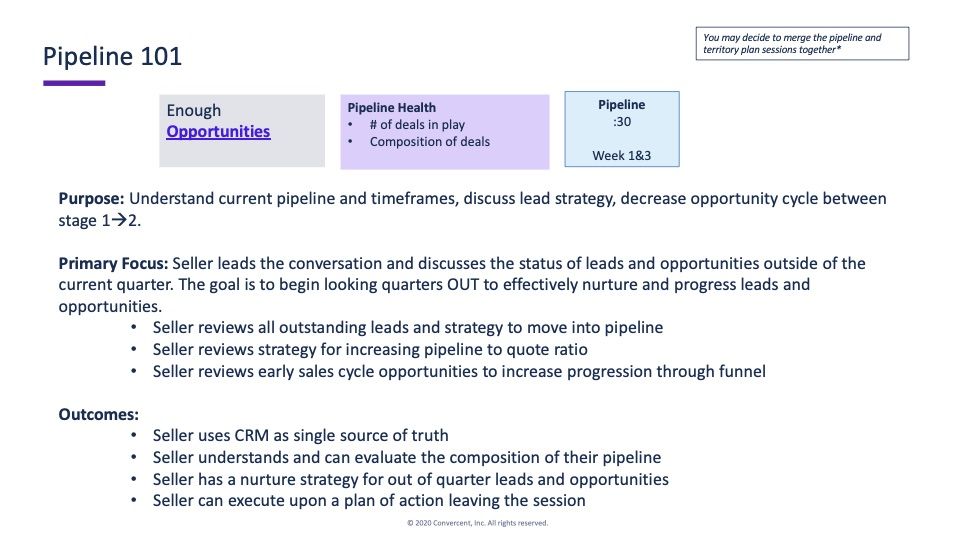
We want to understand the current pipeline and timeframes of pipeline, discuss our lead strategy, decrease our opportunity cycle between our stage one and stage two opportunities.
How can we get more into our lead funnel, and then into our early stages of our opportunities?
Primary focus
The second thing to do is ensure that you've organized your primary focus of who's owning the meeting, and what you expect of them owning the meeting. You can see here that for us, our pipeline meetings are run entirely by our sales reps.
They lead the conversation, they come into the conversation, and they bring all of the relevant information in relation to outstanding leads and strategies to move it into pipeline, their increasing pipeline to quota ratio, their early sales cycle opportunities, and how they plan on getting them through the funnel, their BDR strategies.
They are responsible for bringing all of that to the table.
Outcomes
Finally, the third piece that is extremely important as you're starting to define your operating cadence for specific meetings is what are the outcomes you are expecting?
The outcomes we have been expecting, that we do expect are that our seller understands how they can evaluate the composition of their pipeline.
Can I look at my pipeline strategy and say, "Hey, I'm working on way too many guppies right now and it's taking up so much time. Do I have the permission (because that tends to happen often) to set aside these opportunities that may not be playing as large of a role in me hitting my quota, and therefore the team hitting our quota, and focus more on these tuna and these whale opportunities?"
Not only that, but the seller should always leave these meetings with a plan of action they can go and execute upon.
Let's talk about what this looks like when we break it down even further.
Setting expectations
We set the sales reps and sales leader expectations specifically, and we share this with them as if it is a sales meeting.
One great lesson I have learned about change management for all of you sales leaders out there who are struggling is if you can relate whatever activity you are trying to change the behavior of to an activity your people already understand inherently, for example, the sales motion, you will have a significantly higher likelihood of true change management and progression of whatever opportunity you're trying to face.
The sales rep
For example, for us, when we set the expectations of our sales reps coming prepared to the meeting, we look at it as the sales rep runs this meeting, and the leader is the actual customer, the leader is being sold to essentially.
That being said, the sales rep better come with the collateral that's necessary for the sales leader to be educated on the process. And the sales leader better know their stuff, their territory, their current pipeline numbers, how many opportunities are put in nurture, and what are they doing, for how long have they been in nurture?
- What's happening to them once they've been in nurture for 60 days, and they need to fall out? And
- How are they working with the BDR?
- How are they using other folks within the organization to help them get to their pipeline numbers?
The sales leader
The sales leader on the other hand, when we talk about coaching, has to have some different parameters. The sales leader is the customer in this meeting.
Of course, first and foremost, the sales leader has to be able to sit back and listen actively as the rep defines their numbers.
The more that we try to cut people off in the middle of these sessions, unless they are going down a rabbit hole that's not relevant to the meeting, the less they will believe this meeting is theirs and they own their future. The more they will believe that you are trying to micromanage their pipeline to this specific example.
You have to be willing and ready to allow the sales rep to kick off these meetings, to patiently listen, and take diligent notes on whatever it is that they're saying. Because when you close out this meeting, you want to make sure your sales rep has something to go and act upon.
One of the last pieces is to begin every single meeting you have in your operating cadence by recapping the areas of opportunity from previous sessions.
For example, if our pipeline meetings are every first and third week of the month, at the end of my first pipeline meeting, I am asking my rep, "All right, Maggie, walk me through the areas you are going to focus on for your pipeline health before week three". I'm going to ask Maggie to run me through a mutual action plan of what she's expecting to do and what she needs help with.
I'm going to kickoff meeting three with, "All right, Maggie, you told me you were going to go and execute upon this number of areas of opportunity within your pipeline. Talk to me about how it's going, and then let's get into the numbers".
Everything has to come back around to whatever it is you spoke about before, or else the sales rep will believe you are not doing anything with the information from these meetings.
Getting seller buy-in
It's super important to not fall into sales leader deficit disorder here. It's really important to ensure we're getting sales rep buy-in in doing this because we all know when we have buy-in from our team members, they are so much more likely to participate and to take this and make it their own.
My best suggestion is, in preparation to set up any of these meetings, and within your operating cadence whether you recognize that a forecast meeting as the number one meeting that is going to help you waterfall the rest of your sales process right now, what is a great idea would be to set up your first meeting, call it forecast meeting with your team, and ask your reps to walk you through their current process.
Acknowledge
Acknowledge the current process that they run through, just to listen to it.
Ask
Ask them for gaps they see or areas of opportunity they see within their current process.
Get their perspective on literally what they believe they could be doing better at and where they need help.
Agree
Agree with them upon how you plan to modify this new process into your stage advancement criteria, sales methodology, or whatever it is you're trying to make a change in.
For example, for pipeline health, we're leaving a meeting, our first meeting where we are getting buy-in, and I'm saying to my rep, "All right, Maggie, do we agree that our area of focus is going to be getting opportunities from our lead stage into our S1 stage faster?" "Yes, I agree". We always want to make sure we're leaving in agreement.
Involve
The second to last piece would be to involve others. Get your team together after you've had your one on ones around specific meetings in your operating cadence and talk through what's working and what's not.
Set up
Then set up a true action plan. Another way to actually involve others would be, "Talk me through Maggie how you're leveraging your business development representative to help you with developing pipeline and ensuring you're getting quality leads that are qualified".
We, of course, want to make sure our reps are bought into the strategy and the progress of our sessions.

How can we effectively coach?
One of the ways I've learned to effectively coach that I've actually found is the most impactful I've tried out so far is by the Socratic method.
The Socratic method
The concept of the Socratic method is we're not necessarily looking for the right or wrong answer. So when we ask questions in any one of these meetings within our operating cadence, I'll keep on the path of the pipeline meeting, we're not asking for our reps to understand and say yes or no, to any of the questions we ask.
What we are trying to probe out is how do they think about it today? What's their perspective on the world of pipeline? And therefore, how do they act upon the ways they believe? This will give us a few things.
- First, it helps our reps to actually work through whatever their perspective is, rather than coming to you consistently and asking you what are the right or wrong ways to do things. It's truly helping them go through the learning process within their own mind.
- The second is it helps us identify our areas of gap that we can then go and coach to. Maybe it is "I think about pursuit nurture in this specific way and I think pursuit nurtures can sit in that stage for a whole year". Maybe that's not your process. Maybe you only want pursuit nurtures to sit in that stage for 60 days. How are you going to start to maneuver and express to your sales rep why their plan might not be as successful?
- And it allows you to leverage your sales enablement team, should you have one, for areas of opportunity you might be able to tune in on. Always use your sales enablement team, if that's of access to you, to help with leading these types of coaching sessions.
Whenever we're asking these types of Socratic questions, we want to be asking them in a super broad and very generic way. Again, we're trying to understand how our people think so, therefore, how do they act?
The Socratic method in action: examples
Really, the whole point of the Socratic method is listening actively and following your line of questions by doing so. For example, if I'm sitting with Maggie in a pipeline session, and I'm asking her, "Where is most of your pipeline currently coming from?" And she says, "I don't know".
Well, "Maggie can you talk to me about why you don't know? Can you talk to me about the specific reports you use to track your pipeline? Can you walk me through your relationship with your business development representative, so I can understand a little bit better why this might be a disconnect?"
Or if I asked Maggie the question, "Talk to me about the composition of your pipeline, what types of opportunities tend to fill it?" And she says, "Well, a majority of my pipeline are deals like XYZ company and usually, I'm really struggling with those because they only have a $5,000 ARR", I'm probably talking to Maggie about:
- Who is she going after in her own prospecting time? And
- What is your strategy with her business development representative to ensure she's getting quality pipeline from the larger organizations that will have more of the whale average deal size dollar amount associated?
The real point of this section is to give you some examples of great questions you can use in these sessions and then following this up with "Okay, now you've walked me through areas of opportunity you clearly have, I want you to talk to me about areas you are going to hone in on and execute upon before our next session in a couple of weeks".
This is not to say that in using the Socratic method, you can't also give advice or coaching tips. For example, "Hey, Maggie, I might suggest you sit with your business development representative and walk through a strategy of who it is you're targeting, are these real ideal customer profile accounts? Or are they lower grade, and maybe not as good for your continued pipeline maintenance?"
Next steps
In this article, I have talked through a lot with operating cadence. Of course, when you start getting into conversations around the operating cadence, it can seem like this massive ocean to boil.
In reality, what we need to do is get focused, prioritize, and make sure we have a purpose and intention set so that we can impactfully and effectively coach our team members.
If you want to learn any more about how personally I look at my operating cadence, the ways I help my team members coach, and maybe some ideas on best practices for your Socratic method as you're beginning to hone that in, feel free to reach out to me.
You’ll find me at Maggie.Callahan@Convercent.com or I am very active on LinkedIn so you can find me there.
Thank you.



